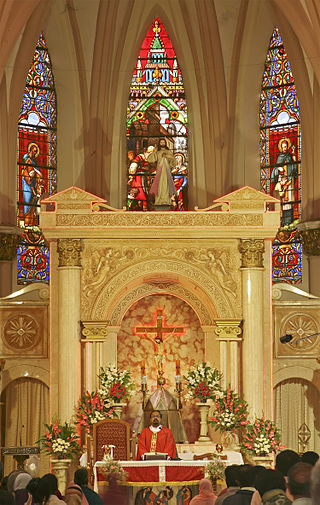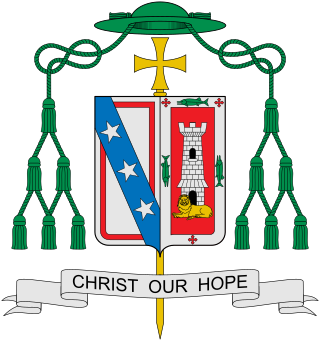
The Mass of Paul VI, also known as the Ordinary Form or Novus Ordo, is the most commonly used liturgy in the Catholic Church. It was promulgated by Pope Paul VI in 1969 and its liturgical books were published in 1970; those books were then revised in 1975, they were revised again by Pope John Paul II in 2000, and a third revision was published in 2002.

The Tridentine Mass, also known as the Traditional Latin Mass or the Traditional Rite, is the liturgy in the Roman Missal of the Catholic Church codified in 1570 and published thereafter with amendments up to 1962. Celebrated almost exclusively in Ecclesiastical Latin, it was the most widely used Eucharistic liturgy in the world from its issuance in 1570 until the introduction of the Mass of Paul VI.

Traditionalist Catholicism is a movement that emphasizes beliefs, practices, customs, traditions, liturgical forms, devotions and presentations of teaching associated with the Catholic Church before the Second Vatican Council (1962–1965). Traditionalist Catholics particularly emphasize the Tridentine Mass, the Roman Rite liturgy largely replaced in general use by the post-Second Vatican Council Mass of Paul VI.

The Cathedral Basilica of Our Lady of Peace is the mother church and cathedral of the Diocese of Honolulu.

Papal inauguration is a liturgical service of the Catholic Church within Mass celebrated in the Roman Rite but with elements of Byzantine Rite for the ecclesiastical investiture of a pope. Since the inauguration of Pope John Paul I, it has not included the 820-year-old (1143–1963) papal coronation ceremony.
Michael Treharne Davies was a British teacher and traditionalist Catholic writer of many books about the Catholic Church following the Second Vatican Council. From 1992 to 2004 he was the president of the international traditionalist Catholic organisation Foederatio Internationalis Una Voce and was responsible for the unification of Una Voce America.

The Roman Rite is the most common ritual family for performing the ecclesiastical services of the Latin Church, the largest of the sui iuris particular churches that comprise the Catholic Church. The Roman Rite governs rites such as the Roman Mass and the Liturgy of the Hours as well as the manner in which sacraments and blessings are performed.
The Liturgical Movement was a 19th-century and 20th-century movement of scholarship for the reform of worship. It began in the Catholic Church and spread to many other Christian churches including the Anglican Communion, Lutheran and some other Protestant churches.

The Mass is the central liturgical service of the Eucharist in the Catholic Church, in which bread and wine are consecrated and become the body and blood of Christ. As defined by the Church at the Council of Trent, in the Mass "the same Christ who offered himself once in a bloody manner on the altar of the cross, is present and offered in an unbloody manner". The Church describes the Mass as the "source and summit of the Christian life", and teaches that the Mass is a sacrifice, in which the sacramental bread and wine, through consecration by an ordained priest, become the sacrificial body, blood, soul, and divinity of Christ as the sacrifice on Calvary made truly present once again on the altar. The Catholic Church permits only baptised members in the state of grace to receive Christ in the Eucharist.
In persona Christi is a Latin phrase meaning "in the person of Christ", an important concept in Roman Catholicism and, in varying degrees, to other Christian traditions, such as Lutheranism and Anglicanism. In Catholic theology, a priest is In persona Christi because, in the sacraments he administers, it is God and Christ who acts through the instrumentality of the priest. An extended term, In persona Christi capitis, “in the person of Christ the head,” was introduced by the bishops of the Vatican Council II in the Decree on the Ministry and Live of Priests, Presbyterorum Ordinis, December 7, 1965.

The development of the ministry of altar server has a long history. In the early Church, many ministries were held by men and women. By the early Middle Ages, some of these ministries were formalized under the term "minor orders" and used as steps to priestly ordination. One of the minor orders was the office of acolyte. Altar servers are a substitute for an instituted acolyte.

Versus populum is the liturgical stance of a priest who, while celebrating Mass, faces the people from the other side of the altar. The opposite stance, that of a priest facing in the same direction as the people, is today called ad orientem or ad apsidem.

Barry Christopher Knestout is an American prelate of the Catholic Church who has served as Bishop of Richmond since 2017.
Richard S. Vosko is an American Roman Catholic priest of the Diocese of Albany and liturgical design consultant who has overseen the redesign and renovation of numerous churches and cathedrals in the United States. Vosko has worked throughout the U.S. and Canada as a designer and consultant for worship environments since 1970.

St. Benedict Cathedral is a Roman Catholic cathedral in Evansville, Indiana, United States. It is the seat of the Diocese of Evansville. The cathedral, rectory and original school building are contributing properties in the Lincolnshire Historic District on the National Register of Historic Places.

The Personal Ordinariate of the Chair of Saint Peter is a Latin Church ecclesiastical jurisdiction or personal ordinariate of the Catholic Church for Anglican converts in the United States and Canada. It allows these parishioners to maintain elements of Anglican liturgy and tradition in their services. The ordinariate was established by the Vatican in 2012.

Steven Joseph Lopes is an American Catholic prelate. He is the bishop of the Personal Ordinariate of the Chair of Saint Peter, a community for clergy and laypeople who celebrate according to the Anglican Use within the Catholic Church.
Spiritus Domini is an apostolic letter in the form of a motu proprio by Pope Francis signed on 10 January 2021 and released the next day. It changed the 1983 Code of Canon Law to allow women to be admitted to the instituted ministries of acolyte and lector (reader), which had until then been exclusively available to men.
Traditionis custodes is an apostolic letter issued motu proprio by Pope Francis, promulgated on 16 July 2021 regarding the continued use of pre-Vatican II rites. It restricts the celebration of the Tridentine Mass of the Roman Rite, sometimes colloquially called the "Latin Mass" or the "Traditional Latin Mass". The apostolic letter was accompanied by an ecclesiastical letter to the Catholic bishops of the world.

In the Catholic Church, preconciliar Latin liturgical rites coexist with postconciliar rites. In the years following the Second Vatican Council, Pope Paul VI initiated significant changes. Some of Paul VI's contemporaries, who considered the changes to be too drastic, obtained from him limited permission for the continued use of the previous Roman Missal. In the years since, the Holy See has granted varying degrees of permission to celebrate the Roman Rite and other Latin rites in the same manner as before the council. The use of preconciliar rites is associated with traditionalist Catholicism.












